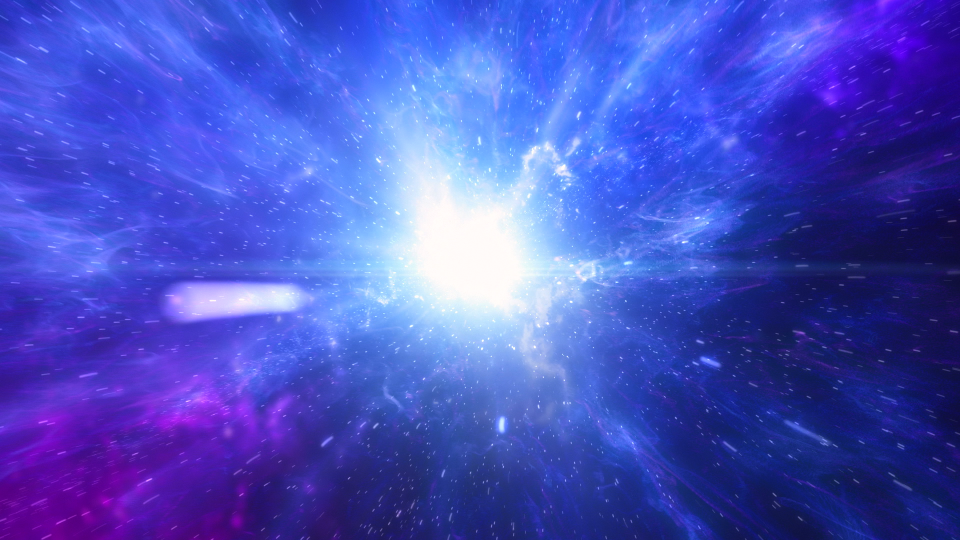Glowing snow is falling thousands of feet under the sea. Here's why.
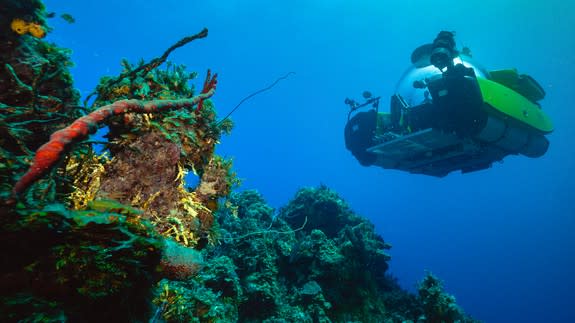
Edie Widder sat quietly in the dark for half an hour.
All around her, critters floated and glided by as she peered through the thick glass bubble of a submersible, perched on a rocky ledge nearly 2,000 feet under the sea.
Everywhere, the creatures glowed.
"It was like an incredible starfield sky," said Widder, the marine scientist who famously attracted a legendary giant squid to the same deep sea submarine, six years earlier. "It was all of these little frothy lengths of luminescence that lit up all around us, and above us."
That August evening, Widder descended down to these depths off the Eastern Bahamas not to seek out any enormous tentacled creatures, but to watch the sea glow.
SEE ALSO: A dominant shark lurks in the deep, dark ocean. Meet the sixgill.
When the submersible — piloted by deep ocean explorers OceanX — has its radiant lights turned on, they illuminate what often looks like snow in different parts of the sea. In some places, "there’s a steady rain, a blizzard of marine snow," said Widder.
Of course, it's different than snow on the surface. Though it looks similar in the light, these snowy particles are not made of frozen water, but of things both alive and dead: tiny, decomposing organisms (plankton), their waste, collections of bacteria, and balls of slime holding this stuff together. It's all gradually sinking to the bottom of the ocean.
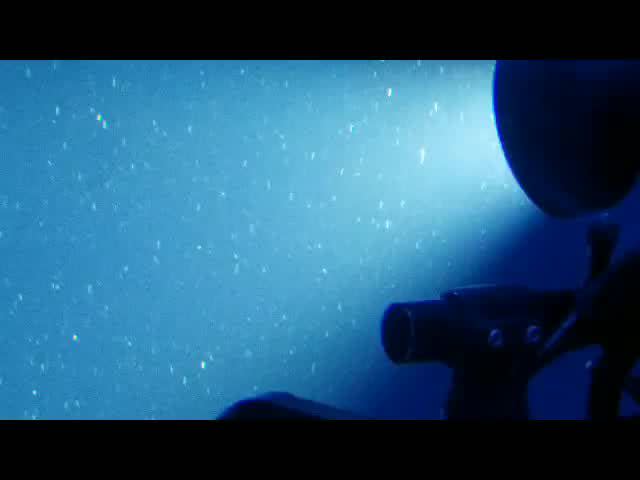
Above: The OceanX submersible descends past flurries of marine snow. Credit: Edie Widder
"In a sense, they’re like a little galaxy of their own in a huge enormous universe of the ocean," Andrew McDonnell, an oceanographer at the University of Alaska Fairbanks who also researches ocean snow, said in an interview. "Each one is made up of lots of living parts."
But the 67-year-old Widder is interested in the glowing kind. She wants to know what's exactly producing these cosmic glows in the deep sea, and why. This interest, however, has advanced well beyond an ordinary research endeavor. Widder calls it a growing "obsession."
"I believe a significant portion of the marine snow is bioluminescent," she said. "I certainly want to know the answer before I die."
"It's my Moby Dick," she added.
A world dependent on snow
Glowing or not, marine snow is found in oceans everywhere, though in varying amounts. The particles' slow descent to the darkest recesses of oceans worldwide are crucial for the planet — and the life down there.
There's no sunshine or sprouting plants in this nighttime world, so the creatures here must depend on what falls down from above.
"Everything is waiting for stuff to come down, whether a dead whale or a marine snowflake," Rainer Kiko, a marine scientist specializing in plankton and marine snow research at the GEOMAR Helmholtz Centre for Ocean Research Kiel in Germany, said in an interview.
"It’s critical to all deep sea life — it's the fuel that feeds the deep sea," added Widder.
But the surface world is, unwittingly, also heavily dependent upon marine snow. Near the ocean's surface, the water is teeming with tiny photosynthetic floating critters, known as phytoplankton. They're responsible for creating nearly all the oxygen on Earth, and become visible during massive blooms, some of which glow.
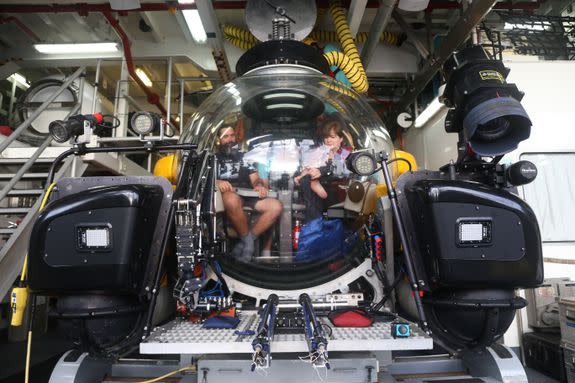
Image: Meghan Gilbert/Cape Eleuthera Island School
They suck carbon from the air throughout their lives, and when they die, their bodies, composed largely of carbon, sink. It's the natural way the oceans help regulate the planet's climate, by trapping carbon down in the ocean depths.
"Without this process — what we call the biological carbon pump — the concentration of carbon dioxide would be about double what it is today," said McDonnell. "It's naturally doing the Earth this giant favor of storing carbon deep in the ocean."
In fact, the oceans contain 50 times the amount of carbon than the atmosphere. The snow that falls to the lightless ocean depths at 1,000 meters will likely "be gone for more than 1,000 years," said Kiko.
And if the snow falls all the way down to the ocean floor, becoming absorbed in the muddy sediments, "it will be gone much longer," he added.
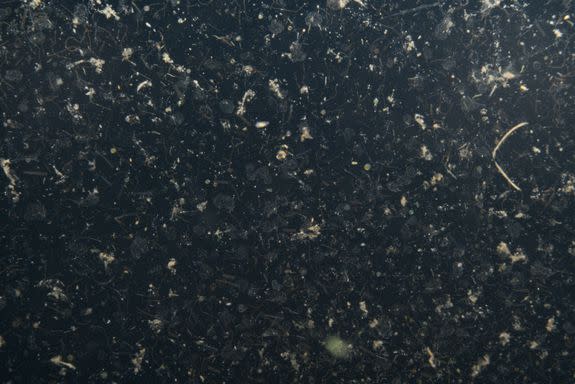
Image: Credit: Andrew McDonnell, University of Alaska Fairbanks
Mysterious glow
As critical as marine snow is to a stable planet and thriving deep sea world, much remains unknown.
Each particle can be a completely different world, or galaxy, as McDonnell put it. Upon closer inspection, they can look like snowflakes, a simple round dot, elongated cylinders, or all of these stuck together in one slimy clump.
"It's still a big mystery," McDonnell said, noting that each of their exact fates is another quandary.
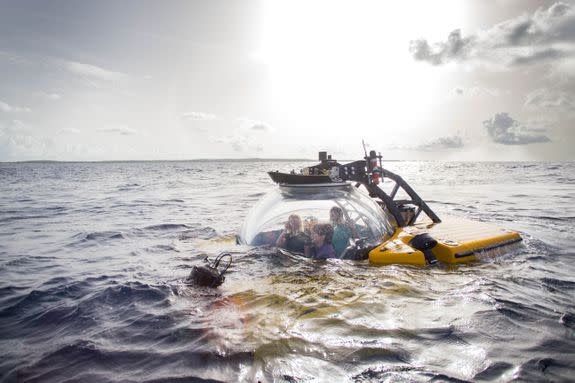
Image: Meghan Gilbert, Cape Eleuthera Island School
What is known, however, is that marine snow flourishes in certain oceans, such as near the equator in the Pacific and Atlantic.
"We saw an amazing equatorial snowfall of particles," said Kiko, who like McDonnell uses a deep sea camera to capture images of marine snow. Some of this abundance is easily explainable, like places where cold, nutrient-rich water often wells up to the surface and sustains lots of life — life that ultimately dies, and sinks.
But what's not explainable — and perhaps the greatest mystery of all — is why some marine snow glows. Widder has been considering the glow for decades.
"I’ve spent so much of my career sitting in the dark," said Widder. "I’ve probably seen it more than anyone else."
Credit: NOAA
A compelling idea is that bioluminescent bacteria, as part of the community inhabiting a snow particle ecosystem, glows to attract other creatures. In the dark, the creatures munch on the marine snow, and in doing so, the bacteria flourishes inside the nutrient-rich creature. This works well for everyone — the consumer and the consumed.
"We’re talking about a pretty important aspect of survival," said Widder. "If your food lights up, that could be very useful."
Yet, even trying to observe the glow happening on a particular snow particle has been trying. Over several night dives in the OceanX submersible, Widder studied the cryptic glow, but next hopes to capture the glowing particles with a high-resolution camera. But getting a tiny glowing particle into the frame isn't easy.
"It's super, super difficult," said Widder.
Even the tiny structure that actually does the glowing remains a mystery to Widder, who describes it as seemingly taking the shape of a tiny bottle brush flower, with specks of light at the end of the filaments.

Image: flicker user Rojer
"I’m at a complete loss as to why it has the apparent structure that it has," she said.
Other scientists have tried to glimpse the glowing particles before. But many snow particles can be pretty small, translucent, and nearly imperceptible.
And that, said Widder, makes the glowing snow all the more difficult to grasp, and yet all the more intriguing.
"You're talking about fairy dust here," she said.
WATCH: Ever wonder how the universe might end?
